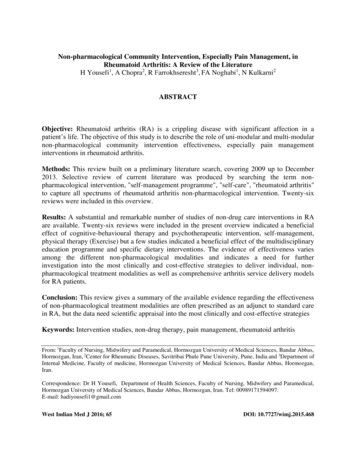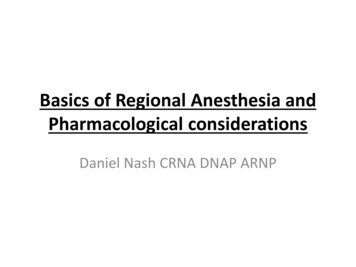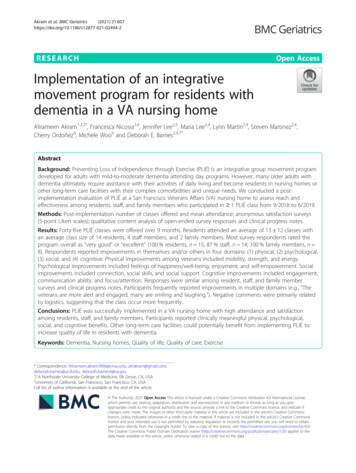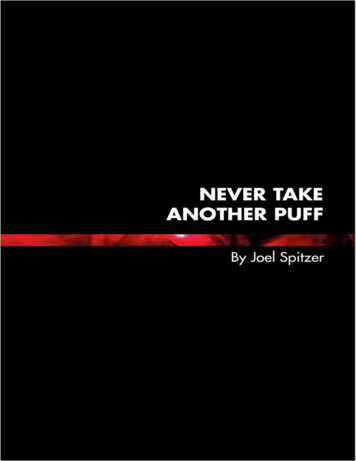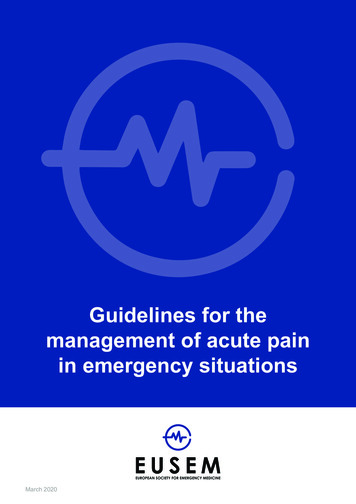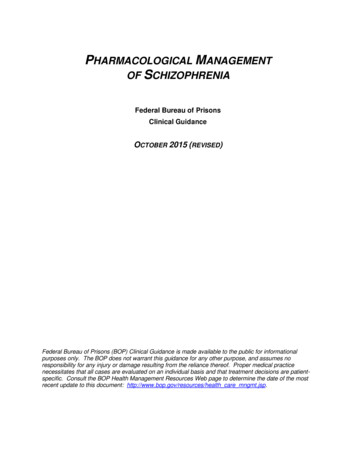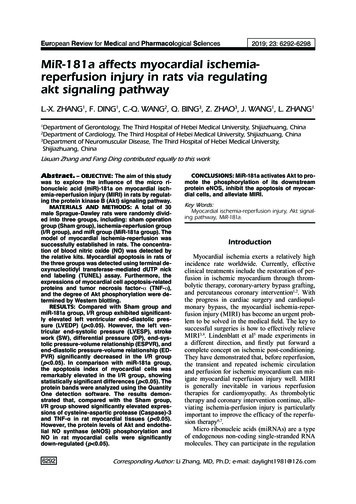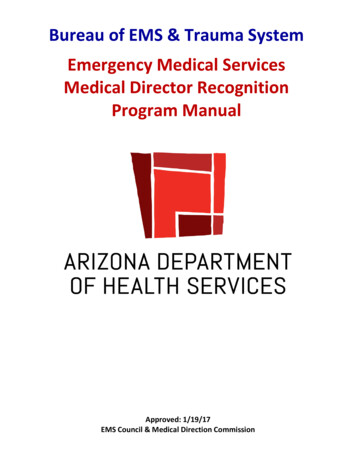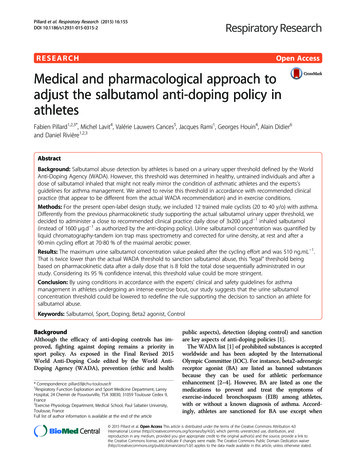
Transcription
Pillard et al. Respiratory Research (2015) 16:155DOI 10.1186/s12931-015-0315-2RESEARCHOpen AccessMedical and pharmacological approach toadjust the salbutamol anti-doping policy inathletesFabien Pillard1,2,3*, Michel Lavit4, Valérie Lauwers Cances5, Jacques Rami1, Georges Houin4, Alain Didier6and Daniel Rivière1,2,3AbstractBackground: Salbutamol abuse detection by athletes is based on a urinary upper threshold defined by the WorldAnti-Doping Agency (WADA). However, this threshold was determined in healthy, untrained individuals and after adose of salbutamol inhaled that might not really mirror the condition of asthmatic athletes and the experts’sguidelines for asthma management. We aimed to revise this threshold in accordance with recommended clinicalpractice (that appear to be different from the actual WADA recommendation) and in exercise conditions.Methods: For the present open-label design study, we included 12 trained male cyclists (20 to 40 y/o) with asthma.Differently from the previous pharmacokinetic study supporting the actual salbutamol urinary upper threshold, wedecided to administer a close to recommended clinical practice daily dose of 3x200 μg.d 1 inhaled salbutamol(instead of 1600 μg.d 1 as authorized by the anti-doping policy). Urine salbutamol concentration was quantified byliquid chromatography-tandem ion trap mass spectrometry and corrected for urine density, at rest and after a90-min cycling effort at 70-80 % of the maximal aerobic power.Results: The maximum urine salbutamol concentration value peaked after the cycling effort and was 510 ng.mL 1.That is twice lower than the actual WADA threshold to sanction salbutamol abuse, this “legal” threshold beingbased on pharmacokinetic data after a daily dose that is 8 fold the total dose sequentially administrated in ourstudy. Considering its 95 % confidence interval, this threshold value could be more stringent.Conclusion: By using conditions in accordance with the experts’ clinical and safety guidelines for asthmamanagement in athletes undergoing an intense exercise bout, our study suggests that the urine salbutamolconcentration threshold could be lowered to redefine the rule supporting the decision to sanction an athlete forsalbutamol abuse.Keywords: Salbutamol, Sport, Doping, Beta2 agonist, ControlBackgroundAlthough the efficacy of anti-doping controls has improved, fighting against doping remains a priority insport policy. As exposed in the Final Revised 2015World Anti-Doping Code edited by the World AntiDoping Agency (WADA), prevention (ethic and health* Correspondence: pillard.f@chu-toulouse.fr1Respiratory Function Exploration and Sport Medicine Department, LarreyHospital, 24 Chemin de Pouvourville, TSA 30030, 31059 Toulouse Cedex 9,France2Exercise Physiology Department, Medical School, Paul Sabatier University,Toulouse, FranceFull list of author information is available at the end of the articlepublic aspects), detection (doping control) and sanctionare key aspects of anti-doping policies [1].The WADA list [1] of prohibited substances is acceptedworldwide and has been adopted by the InternationalOlympic Committee (IOC). For instance, beta2-adrenergicreceptor agonist (BA) are listed as banned substancesbecause they can be used for athletic performanceenhancement [2–4]. However, BA are listed as one themedications to prevent and treat the symptoms ofexercise-induced bronchospasm (EIB) among athletes,with or without a known diagnosis of asthma. Accordingly, athletes are sanctioned for BA use except when 2015 Pillard et al. Open Access This article is distributed under the terms of the Creative Commons Attribution 4.0International License (http://creativecommons.org/licenses/by/4.0/), which permits unrestricted use, distribution, andreproduction in any medium, provided you give appropriate credit to the original author(s) and the source, provide a link tothe Creative Commons license, and indicate if changes were made. The Creative Commons Public Domain Dedication o/1.0/) applies to the data made available in this article, unless otherwise stated.
Pillard et al. Respiratory Research (2015) 16:155taking salbutamol, salmeterol and formoterol, for medicalreasons, by inhalation, at a maximum dose and the urineconcentration must not exceed a threshold value for salbutamol and formoterol.Salbutamol is one of the most popular short-acting BA(SABA) used to relieve asthma symptoms. This medication can prevent asthma symptoms and should be taken10 to 15 min before exercise. It will help prevent symptoms for up to four hours. Salbutamol can also be usedto treat and reverse the symptoms of EIB. Based on thecurrent WADA guidelines, the SABA salbutamol can beprescribed up to 1600 μg per 24 h. According to recentexpert clinical guidelines from Global Initiative forAsthma (GINA) recommendations [5] and the AmericanThoracic Society (ATS) Clinical practice guidelines [6],SABAs can be prescribed during sport practice to preventEIB, just before exercise: inhaled doses of 200–400 μgcould be inhaled just before exercise as suggested by Tanet al. [7]. In addition, doses between 400 to 800 μg can beinhaled up to the 2nd or 4th hour of asthma attack, andthen repeated if necessary but this situation should beconsidered with caution among athletes because acuteand intense exercise triggers EIB [8]. Anyway, inhalationof 1600 μg is neither encouraged in a day for preventionof EIB. To justify the WADA daily upper limit of1600 μg.d 1 for inhaled salbutamol (a limit that is 2 · 5 foldhigher than the limit proposed by experts in asthma),Dickinson et al. suggested that this limit was proposed byWADA to take into account the fact “that asthmatic athletes are often instructed to use their inhaler on an asneeded basis that could be interpreted by the athletes as aclearance to inhale unlimited amounts of salbutamol tocombat respiratory symptoms” [9]. However, this assertionis in contradiction with experts guidelines cited above(GINA and ATS recommendations) and with recommendations published in a very recent review published byBoulet et al. [10]. According to these guidelines andrecommendations, SABAs should be used only as-neededat the lowest dose and frequency required to preventeventual tachyphylaxis. Moreover, this assertion could bediscussed based on clinical practice and ethical considerations. Indeed asthma requiring such high BA dosesshould not be compatible with current high level physicaland sports performance if we consider that the high levelsof ventilation sustained in such exercise conditions areidentified as triggers for EIB [2].A second question concerns the maximum urine concentration of salbutamol accepted in the case of “therapeutic prescription”. Historically, salbutamol was the firstbronchodilatator listed in the international anti-doping listaccording to a urinary threshold for sanction. Accordingto Dickinson [9], this current WADA urinary threshold(1000 ng.mL 1) is based on data published in 2000 byBerges et al. [11]. In this study, non-asthmatic recreationalPage 2 of 10swimmers inhaled 1600 μg salbutamol and then the urinesalbutamol concentration was determined at rest. Thisstudy, like all the other studies consecutively publishedwith the objective of assessing salbutamol pharmacokinetics after inhalation or oral administration (Table 1), wasnot conducted in asthmatic competitive athletes and samples were not collected during exercise. Therefore, it canbe concluded that no study was conducted in laboratoryconditions mirroring the exercise conditions experiencedby asthmatic athletes. In addition, none of the studies onsalbutamol was performed using an adjusted and clinicalrelevant dose of salbutamol to manage asthma or EIB inathletes (i.e., a dosing regimen in accordance with experts’recommendations in the field).Accordingly, the objective of our study was to assess thepharmacokinetics of inhaled salbutamol 1) in asthmaticathletes and 2) after a single bout of intense exercise and3) after a recommended (by experts in asthma but notaccording to the WADA list) dosing regimen of inhaledsalbutamol for athletes undergoing an intense exercisebout (i.e. 200 μ.d 1 of salbutamol three times per day).MethodsStudy designThis study used an open-label design. All participantsvisited our laboratory four times. During the first visitthe diagnosis of asthma was confirmed by direct bronchial provocation test with methacholine chloride. During the second visit, the endurance capacity was assessedto determine the intensity of the exercise session. Then,two consecutive sessions were dedicated to assessing salbutamol pharmacokinetics in plasma and urine at rest(rest pharmacokinetic session, D1) and, the next day,during a bout of intense endurance exercise (exercisepharmacokinetic session, D2). Participants were asked tostop their current anti-asthmatic treatment three daysbefore the rest pharmacokinetic session and to inhalesalbutamol three times per day (see the Medications section; study design is presented in Fig. 1).The study protocol was approved by the scientificcommittee of the French Anti-Doping Agency and bythe Toulouse hospital ethics committee (agreement n 0830103).Participants and lung function assessmentThis study included 12 men, aged between 20 and40 year. They were trained cyclists and were enrolled inthe study if they practiced eight hours or more of cyclingper week. All were enrolled in competition. All werenon smokers. All experienced clinical symptoms ofasthma according to GINA classification, including EIBand all had been using a SABA on demand for at leastone year. All the patients used SABA at least one timeduring the two weeks before their enrollment in the study.
Pillard et al. Respiratory Research (2015) 16:155Page 3 of 10Table 1 Published studies on the pharmacokinetics of inhaled salbutamol (updated on the 31st July 2014)Physical activityAsthmatic statusSalbutamol inhaled doseRest or exerciseAnderson1998 [26]UntrainedHealthy1 180 μgRestExercise intensity10Sample sizeBerges2000 [11]TrainedAsthmatic1 200 μgRest15Healthy4 400 μgPichon2006 [27]TrainedHealthy3 200 μgRest10Sporer2008 (1) [28]TrainedHealthy1 200 μgExercise(and Rest)17and 1 400 μgCycling time30and 1 800 μgSporer2008 (2) [29]UntrainedHealthy1 200 μgRest8Elers2010 [30]UntrainedAsthmatic1 200 μgRest10Elers2011 [31]UntrainedAsthmatic4 400 μgRest10Elers2012 [19]TrainedAsthmatic1 800 μgRest10Dickinson2014 [9]TrainedHealthy1 800 μgExercise(and Rest)Notspecified32Theoretical “Link-field study”TrainedAsthmaticExercise(and Rest)ExercisePowerfulHealthy10Healthyand 1 1600 μgPreventivedose:3 200 μgBold data identify conditions that we consider as optimal based on a rigorous clinical and scientific approachPatients reported they used SABA some days before exercise when they observed a “short breath” compared toother days. No one had ever had a severe asthma attack.In the absence of exacerbations, our cohort was defined asa mild asthma cohort.Only men were studied in this preliminary study to exclude any pharmacological variation related to menstrualhormonal disturbances in women.Written informed consent was obtained by all subjects.The methacholine challenge test was used to confirmthe diagnosis of asthma and a negative challenge testwas used to exclude the diagnosis of asthma. All the participants were asked to stop their SABA at least 48 h before lung function assessment [12]. Pulmonary functiontesting was done using a whole body plethysmograph(Jaeger Master Screen Body Plethysmograph). Themethacholine challenge test was performed using theaerosol provocation system (APS) dosimeter techniqueMetacholinechallenge testD-3D-2D-1D1D290’ - 70-80% MAPMaximal enduranceexercise testt0 t0 30’ t0 2h t0 4h t0 6h8:00 am2:00 pm 8:00 pmt0 t0 30’ t0 2h t0 4h t0 6h8:00 am2:00 pm//LegendsUrine sampleFig. 1 Study design200 µg Salbutamol inhalation (8:00 am, 2:00 pm and 8:00 pm)
Pillard et al. Respiratory Research (2015) 16:155(APS, Viasys) [13]. The cumulative dose of methacholine provoking a 20 % decrease (PD20) in the forcedexpiratory volume in 1 s (FEV1) was calculated toconfirm the participant’s asthmatic status. Accordingto the ATS guidelines, the PD20 threshold was set at1600 μg [12, 13].Endurance exercise testing and endurance exerciseduring the exercise pharmacokinetic sessionThe participant’s endurance capacity was assessed tocheck their fitness level. To this aim, maximal graded exercise tests were conducted in our laboratory. Subjectsused their own bicycle and equipment. The power outputwas assessed using the Power Tap mobile cycling ergometer (Cycle Ops, Madison, WI, USA) [14]. During the test,oxygen consumption (VO2, expressed in L.min 1 andmL.min 1.kg 1) was assessed using an Oxycon Pro ergospirometer (Erich Jaeger, Viasys Healthcare, Germany).The VO2max and its corresponding power, the maximalaerobic power (MAP) were measured.During the exercise pharmacokinetic session, subjectsperformed a 90 min bout of endurance exercise in thesame general conditions as for the MAP determination(i.e., on their own bicycle and power output wasassessed by using the Cycle OPS Power Tap system).After 10-min warm up at 60 % of their MAP, participants were asked to exercise at 70–80 % of their MAPfor the last 80 min.MedicationsAt enrolment, all participants declared salbutamol useon demand (2 100 μg.d 1 just before exercise or in caseof asthma symptoms). None of them reported salbutamol dose higher than 400 μg.d 1 over the past year before enrolment in this study. Four declared a treatmentto control asthma (see Subjects in the Results section).All subjects had to abstain from using any medicine, including SABA, 2 weeks before the pharmacokineticsession.The protocol of the study is detailed in Fig. 1. At leastone week before the rest pharmacokinetic session (D1,Fig. 1), all participants received a full salbutamol aerosolinhaler and a valve holding chamber. To follow salbutamol consumption, the weight of two puffs was arbitrarilydefined by weighing each inhaler before and after 4 puffsand the weigh difference divided by two.Each participant received written and oral instructionsto inhale salbutamol three times a day (2 puffs/eachtime). Participants were asked to inhale 200 μg salbutamol three times daily scheduled for 3 consecutive days(D1-3, D1-2, D1-1). This scheme of salbutamol inhalation was reproduced on the 4th consecutive day designed as the rest pharmacokinetic session (D1). FromD1-3 to D2 (exercise pharmacokinetic session, next dayPage 4 of 10after D1), salbutamol was administered in the same conditions. Participants were asked to bring back the inhalerat D2. At the end of the exercise pharmacokinetic session, the inhaler was weighted again and the differencein weight was used to control salbutamol administration.Despite subjects enrolled in the study were not undera daily salbutamol inhalation treatment scheme, regularand pre-exercise inhalation of salbutamol were proposedfor the study to mimic a treatment scheme by SABAthat might be proposed as a part of the global treatment(SABA and addition of a controller) for more severeasthmatics. The dose of 200 μg for each of the threedaily inhalations was defined because this dose is closeto the maximal dose recommended before exercise(400 μg) while this dose would be usual for mild asthmatic subjects.Urine sampleDuring the rest and exercise pharmacokinetic sessions,urine was collected at baseline (T0) and at 30 min, 2 h(i.e., just after the 90-min intense exercise in the case ofthe exercise pharmacokinetic session), 4 h and 6 h afterthe first dose of 200 μg of salbutamol. Participants wereencouraged to drink water regularly to favour urine excretion for sampling. Night urine was collected at homeby the participants in a dark container and delivered toour laboratory kept out from light. For each time point,the total urine sample volume was recorded and two30 mL aliquots were stored at 80 C until analysis.Bioanalytical analysis of urine samplesUrine samples were pre-treated according to the currentprocedures used by anti-doping laboratories to detecttotal salbutamol (i.e., salbutamol and its glucuronide)[15]. Salbutamol-D9 was used as internal standard. Afterextraction from urine by solid-phase extraction, salbutamol concentration was assessed by hydrophilic interaction chromatographic and liquid chromatography withatmospheric pressure chemical ionization mass spectrometry. Bioanalytical analyses were performed at thePharmacokinetic and Toxicological Laboratory of Toulouse Hospital (France). This laboratory is accredited byCOFRAC, the French accreditation body, under theEuropean norm n 1589.Urine salbutamol concentration values were correctedto the urine density, as previously recommended [9].The maximum urine concentration of salbutamol foreach participant and for each experimental session wasdefined as the highest value for each session (Cumax-restand Cumax-ex, in ng.mL 1, were labeled for resting andexercising session respectively). For each participant, thehighest of these values was defined as the Cumax (themaximum urine concentration of salbutamol that could
Pillard et al. Respiratory Research (2015) 16:155Page 5 of 10be detected for each participant, regardless the specificrest or post-exercise conditions).Statistical analysisSample size calculation to fit well-powered analysis inorder to test our main hypothesis was based on the salbutamol concentration distribution in urine samples described by Tomlinson et al. [16] and with the aim ofcomputing the confidence interval for salbutamol concentration in urine according to the general methodological recommendations by Gardner and Altman [17]and the recommendations edited by an Expert Panel onTheory of Reference Values from the International Federation of Clinical Chemistry and Laboratory Medicine[18]. We thus needed to include 12 subjects to assume aprecision of 85 and a 95 % confidence level for the confidence interval. The confidence intervals of salbutamoldistribution were computed for 95 and 99 % confidencelevels.For bivariate analysis, the normality of distribution ofquantitative variables was tested using the skewness andkurtosis test (sktest). As some variables differed from thenormal distribution, bivariate analysis was performedusing the Wilcoxon matched-pairs ranks test or theFriedman’s test for repeated variables. Bivariate analysis wascarried out with a significance level 0 · 05. For repeatedvariables, a Bonferroni adjustment of this significance levelwas performed to conclude on the significance of the corresponding multiple comparisons (corresponding to multipletime points).All statistical analyses were performed with the Stata6 · 0 software (Stata Corporation, College Station, TX).Table 3. According to the ATS categorization of bronchialhyper-responsiveness (BHR), four participants (33 · 3 %)had moderate to severe BHR, two (16 · 7 %) had mild BHRand six (50 %) were borderline. Four subjects declared atreatment to control asthma: 10 mg.d 1 montelukast(n 1), 50 μg.d 1 salmeterol fluticasone (n 1), 12 μg.d 1formoterol (n 1) or 12 μg.d 1 formoterol budenoside (n 1). As required, these subjects stopped theirstandard treatment 2 weeks before the first pharmacokinetic session (D1).All the subjects practiced cycling at competitive leveland were well-trained endurance athletes as indicated bytheir VO2max and MAP/kg values.Urine densityAs participants were encouraged to drink water ad libitum to ensure diuresis (required for urine sampling),urine density significantly decreased from the beginningto the end of each session (Fig. 2).Salbutamol urinary concentrationFigure 3a and b present the distribution of salbutamolconcentration in urine during the rest and exercise sessions, respectively. Table 4 presents the distribution ofCumax-rest, Cumax-ex and Cumax and their confidenceinterval. Cumax was observed in ten participants duringthe exercise session and in nine after the exercise bout.The maximal concentration was measured at 2:00 pm(i.e., 4 h after the exercise bout). Based on the uppervalue of the 95 and 99 % confidence intervals, thethreshold value of urine salbutamol for anti-doping control could be stricter, at 327 · 7 and 372 · 4 ng.mL 1respectively.ResultsSubjectsTwelve subjects (mean age: 29 years 8 · 6 SD) were recruited. Baseline lung function assessed by whole-bodyplethysmography was in the normal range for all theubjects (Table 2). Mean PD20 was 587 μg ( 535 SD).Functional aerobic assessment (VO2max, MAP and maximum heart rate) and the mean power sustained duringthe exercise pharmacokinetic session are presented inTable 2 Distribution of baseline respiratory characteristics of thesubjects (n 12 male 11612 · 0Forced vital capacity9711813011711 · 6FEV1931101251109·1FEV1/FVC ratio757892796·7PD20; μg505351500587535Abbreviations: TLC total lung capacity, FVC forced vital capacity, FEV1 onesecond forced expired volume, FEV1/FVC ratio Tiffeneau-Pinelli index. Data forTLC, FVC, FEV1 and FEV1/FVC ratio are % of the corresponding predicted valueDiscussionOne could argue that there is no need to change therules but rather to educate athletes, coaches and thehealth care providers who care about the proper use ofSABAs rather than to prevent athletes from participating. However, sanction against cheaters remains a keypoint to fight against doping in sport and we need to improve the judgment criteria before adopting any disciplinary sanction against an athlete. By using conditions inaccordance with the experts’ clinical and safety guidelinesfor asthma management in athletes undergoing an intenseexercise bout, our study demonstrates that the urine salbutamol concentration threshold could be lowered to redefine the rule supporting the decision to sanction anathlete for salbutamol abuse. Under a minimal inhaled salbutamol dose regimen, our study demonstrates that aurine salbutamol concentration threshold of 507 ng.mL 1could be used to redefine the rule supporting the decisionto sanction an athlete for salbutamol abuse. This thresholdis very far from the actual WADA threshold defined for a
Pillard et al. Respiratory Research (2015) 16:155Page 6 of 10Table 3 Distribution of the results of functional aerobic assessment of the subjects (n 12 male participants; VO2max: maximaloxygen uptake; MAP: maximal aerobic power; SD: standard deviation)Minimum 1MedianMaximumMeanSDVO2max; mL.min2800380047003858340VO2max; mL.min 1.kg 1415967578·4MAP; watts21030534029440MAP/weight; watt.kg 13.34.45.14.30·6Maximum heart rate; beats.min 11771922141939·9Mean power during exercise session; watts16022525021531 · 6Mean power during exercise session; ratio to MAP %62 · 17481 · 073 · 25·7Clinical Immunology: “Although treatment of EIB hasbeen extensively studied in asthmatic subjects, it wasnot so in athletes with EIB and it is not known whetherathletes with EIB respond similarly to subjects with classical allergic or nonallergic asthma” [20]. Such a methodological defect can also be highlighted in recentstudies supporting the WADA restrictions to detect anabuse of inhaled formoterol according to formoterolconcentration in urine [21]. Our study is the first to follow this new methodological approach as asthmatic andtrained subjects were tested during a bout of intense exercise. Our study could have been done in controls subjectsdefined as non-asthmatic athletes to clearly identify theimpact of the asthmatic status on salbutamol pharmacokinetic in urine but we were limited by organizational conditions. Elers tried to give an answer to this question afteradministration of a single high inhaled dose of salbutamol(800 μg) [22]. However he selected nonathletic subjects ascontrols and despite he found no influence of asthma onurine salbutamol concentration, this question remainsnot recommended inhaled salbutamol dose. Even a “statistically” more stringent threshold could be proposed ifanti-doping instances planned to consider the upper limitof the 99 % confidence interval of salbutamol concentration in urine, and not the absolute maximum value detected. Our proposal to implement a new threshold issupported by methodological points supporting scientificbased bases for anti-doping policy. However, this proposalis also closely related to some other methodological pointsthat make our proposal too conservative to be applied forthe heterogeneous population of asthmatic athletes.Recently, Elers et al. highlighted methodological concerns that should be taken into account in scientificstudies to support anti-doping policies against salbutamol abuse. Salbutamol dosing regimen, athletic statusand testing conditions (rest/exercise) were previouslyshown to influence the pharmacokinetics of inhaled salbutamol [19]. This methodological concern was alsostressed by the Joint Task Force of European RespiratorySociety and the European Academy of Allergy andUrine densityRest session1.035Time effect during rest session (Friedman test): p 0.05Exercise session1.030Time effect during exercise session (Friedman test): p 0.051.0251.0201.0151.0101.0051.000t0t0 30't0 2ht0 4ht0 6hTimeFig. 2 Urine density variation during the rest (dark grey columns) and exercise (light grey columns) pharmacokinetic sessions. Stratified on rest orexercise session, repeated measures were assessed using the Friedman’s test: p 0.05 for the time variation of urine density during rest andexercise sessions
Pillard et al. Respiratory Research (2015) 16:155Page 7 of 10abRest sessionExercise sessionRest sessionExercise sessionFig. 3 a Salbutamol urine concentration (ng.mL 1) before (dark grey columns) and after correction (light grey columns) for urine density duringthe rest pharmacokinetic session. Bivariate comparisons (Wilcoxon sign rank test) between corrected and uncorrected time-stratified values.Bonferroni correction of the significance level: * p 0.01. b Salbutamol urine concentration (ng.mL 1) before (dark grey columns) and aftercorrection (light grey columns) for urine density during the exercise pharmacokinetic session. Bivariate comparisons Wilcoxon (sign rank test)between corrected and uncorrected time-stratified values. Bonferroni correction of the significance level: *p 0.01unresolved to implement some scientific data that couldbe useful to enhance specificity of the detection of salbutamol abuse in asthmatic but also nonasthmatic athletes.Moreover, urine density correction of urine salbutamolconcentration must be considered to minimize the effectof this biological condition on the anti-doping judgmentcriteria [19]. While this correction was not applied tourine salbutamol concentration proposed in the articleby Berges et al. [11] that was used to define the actualupper threshold in the WADA prohibition list, we considered this potent bias and we corrected the urine salbutamol concentration for urine density. This correctionis of interest to take into account the state of hydrationbecause dehydration alters the urine specific density, forexample during intense and prolonged exercise, thus favoring an overestimation of urine salbutamol [9].According to these two methodological points, ourstudy mirror field sports practice and it could help toimplement some required medical and scientific basedbases for doping control management [23].The urine concentration threshold derived from ourstudy after a daily minimal dose of inhaled salbutamol toprevent EIB (3 200 μg) is twice lower than the actualthreshold of 1000 ng.mL 1 proposed in the WADA prohibited list to sanction salbutamol abuse. However, this“legal” threshold is based on pharmacokinetic data after
Pillard et al. Respiratory Research (2015) 16:155Page 8 of 10Table 4 Distribution of the urine density corrected maximumurine concentration of salbutamol at rest (Cumax-rest), after theacute exercise bout (Cumax-ex) and regardless these specificrest or post-exercise conditions (highest of these specific valuesfor each participant, Cumax)Cumax-restCumax-exCumaxng.mL 1ng.mL 1ng.mL–1Minimum46 · 9*47 · 466 · 0Median134 · 7*116 · 4127 · 2Maximum276 · 7*507 · 2507 · 2Mean144 · 6208 · 9218 · 8Standard deviation74 · 7179 · 4171 · 395 % CI94 · 4 – 194 · 794 · 9 – 322 · 8110 · 0 – 327 · 799 % CI73 · 2 – 215 · 648 · 1 – 369 · 765 · 2 – 372 · 495 % CI: 95 % Confidence Interval. *Wilcoxon test between rest and exercisevalues: p 0.04a daily dose of 1600 μg inhaled salbutamol, i.e. 8 fold thetotal dose sequentially administrated in our study. Despite regular daily chronic use of salbutamol as a controller is not recommended by current guidelines, we justifythe three times daily inhalation of salbutamol scheduledfor the present study to prevent asthma symptoms inthe four patients who declared a daily treatment to control asthma. These patients were asked to abstain fromusing this treatment 2 weeks before the pharmacokineticsession to avoid a potent influence of such treatmentson salbutamol kinetic, as previously suggested for inhaled corticosteroids for example [24]. The dosing regimen was justified to ensure homogeneity of thepharmacological condition proposed in all volunteers.After such a preliminary study, we highlight that influence of a treatment to control asthma on inhaled salbutamol kinetic in exercise condition and in asthmaticathletes would be of interest to optimize sensitivity andspecificity of salbutamol abuse detection in sport fieldconditions.At the present time, experts’ guidelines for EIB do notexplicitly state an optimal or minimal dose of salbutamolbut ATS EIB guidelines do cite a reference which statesthat a patient should be instructed to use two (200 μg)to four (400 μg) puffs of an inhaled SABA 30 to 60 minbefore exercise [7]. Thus, considering that more severeasthmatics undergoing very intense exercise for prolonged periods might require additional doses o
(SABA) used to relieve asthma symptoms. This medica-tion can prevent asthma symptoms and should be taken 10 to 15 min before exercise. It will help prevent symp-toms for up to four hours. Salbutamol can also be used to treat and reverse the symptoms of EIB. Based on the current WADA guidelines, the SABA salbutamol can be prescribed up to 1600 .
